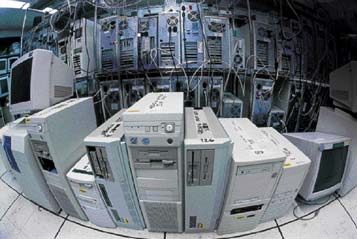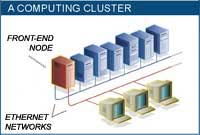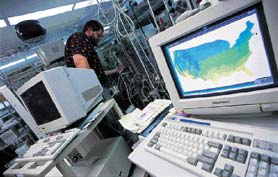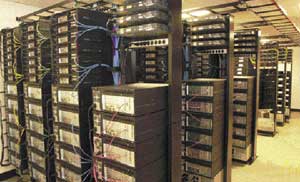|
Monday, August 13, 2001
How To Build A Supercomputer?
Now there is
a fast & cheap way
to solve very difficult computations
By William W. Hargrove, Forrest M. Hoffman
and Thomas Sterling
Scientific American
NEW YORK -- In the well-known
fable "Stone Soup" a wandering soldier stops at a poor
village and says he will make soup by boiling a cauldron of water
containing only a shiny stone. The townspeople are skeptical at
first but soon bring small offerings: a head of cabbage, a bunch
of carrots, a bit of beef. In the end, the cauldron is filled with
enough hearty soup to feed everyone. The moral: cooperation can
produce significant achievements, even from meager, seemingly insignificant
contributions.
 |
| Cluster
of PCs at the Oak Ridge National
Lab in Tennessee has been dubbed the Stone Souper Computer. |
Researchers are now using
a similar cooperative strategy to build supercomputers, the powerful
machines that can perform billions of calculations in a second.
Most conventional supercomputers employ parallel processing: they
contain arrays of ultrafast microprocessors that work in tandem
to solve complex problems such as forecasting the weather or simulating
a nuclear explosion.
Made by IBM, Cray and other computer vendors,
the machines typically cost tens of millions of dollars--far too
much for a research team with a modest budget. So over the past
few years, scientists at national laboratories and universities
have learned how to construct their own supercomputers by linking
inexpensive PCs and writing software that allows these ordinary
computers to tackle extraordinary problems.
 |
| A computing Cluster. The Stone SouperComputer
at Oak Ridge National Laboratory consists of more than 130 PCs
linked in a computing cluster. One of the machines serves as
the front-end node for the cluster; it has two Ethernet cards,
one for communicating with users and outside networks, and the
other for talking with the rest of the nodes in the cluster.
The system solves problems through parallel processing: It divides
the computational workload into many tasks, which are assigned
to the nodes. The PCs coordinate their tasks and share intermediate
results by sending messages to one another. |
In 1996 two of us (Hargrove and Hoffman) encountered
such a problem in our work at Oak Ridge National Laboratory (ORNL)
in Tennessee. We were trying to draw a national map of ecoregions,
which are defined by environmental conditions: all areas with the
same climate, landforms and soil characteristics fall into the same
ecoregion. To create a high-resolution map of the continental U.S.,
we divided the country into 7.8 million square cells, each with
an area of one square kilometer. For each cell we had to consider
as many as 25 variables, ranging from average monthly precipitation
to the nitrogen content of the soil. A single PC or workstation
could not accomplish the task. We needed a parallel-processing supercomputer--and
one that we could afford!
Our solution was to construct a computing
cluster using obsolete PCs that ORNL would have otherwise discarded.
Dubbed the Stone SouperComputer because it was built essentially
at no cost, our cluster of PCs was powerful enough to produce ecoregion
maps of unprecedented detail.
Other research groups have devised even
more capable clusters that rival the performance of the world's
best supercomputers at a mere fraction of their cost. This advantageous
price-to-performance ratio has already attracted the attention of
some corporations, which plan to use the clusters for such complex
tasks as deciphering the human genome. In fact, the cluster concept
promises to revolutionize the computing field by offering tremendous
processing power to any research group, school or business that
wants it
 |
| "CRASH CART"
with a monitor and keyboard diagnoses problems with the Stone
SouperComputer. |
The notion of linking computers together is not new. In the 1950s
and 1960s the U.S. Air Force established a network of vacuum
tube computers called SAGE to guard against a Soviet nuclear
attack. In the mid 1980s Digital Equipment Corporation coined
the term "cluster" when it integrated its mid-range VAX minicomputers
into larger systems. Networks of workstations--generally less powerful
than minicomputers but faster than PC soon became common at
research institutions. By the early 1990s scientists began to consider
building clusters of PCs, partly because their mass-produced microprocessors
had become so inexpensive. What made the idea even more appealing
was the falling cost of Ethernet, the dominant technology for connecting
computers in local-area networks.
Advances in software also paved the way for
PC clusters. In the 1980s Unix emerged as the dominant operating system
for scientific and technical computing. Unfortunately, the operating
systems for PCs lacked the power and flexibility of Unix. But in 1991
Finnish college student Linus Torvalds created Linux, a Unix-like
operating system that ran on a PC.
Torvalds made Linux available free of charge
on the Internet, and soon hundreds of programmers began contributing
improvements. Now wildly popular as an operating system for stand-alone
computers, Linux is also ideal for clustered PCs.
The first PC cluster was born in 1994 at
the NASA Goddard Space Flight Center. NASA had been
searching for a cheaper way to solve the knotty computational problems
typically encountered in earth and space science. The space agency
needed a machine that could achieve one gigaflops -- that is, perform
a billion floating-point operations per second. (A floating-point
operation is equivalent to a simple calculation such as addition or
multiplication.) At the time, however, commercial supercomputers with
that level of performance cost about $1 million, which was too expensive
to be dedicated to a single group of researchers.
One of us (Sterling) decided to pursue the
then radical concept of building a computing cluster from PCs. Sterling
and his Goddard colleague Donald J. Becker connected 16 PCs,
each containing an Intel 486 microprocessor, using Linux and a standard
Ethernet network. For scientific applications, the PC cluster
delivered sustained performance of 70 megaflops -- that is, 70 million
floating-point operations per second. Though modest by today's standards,
this speed was not much lower than that of some smaller commercial
supercomputers available at the time. And the cluster was built for
only $40,000, or about one tenth the price of a comparable commercial
machine in 1994.
NASA researchers named their cluster
Beowulf, after the lean, mean hero of medieval legend who defeated
the giant monster Grendel by ripping off one of the creature's arms.
Since then, the name has been widely adopted to refer to any low-cost
cluster constructed from commercially available PCs. In 1996 two successors
to the original Beowulf cluster appeared: Hyglac (built by
researchers at the California Institute of Technology and the Jet
Propulsion Laboratory) and Loki (constructed at Los Alamos
National Laboratory). Each cluster integrated 16 Intel Pentium
Pro microprocessors and showed sustained performance of over one
gigaflops at a cost of less than $50,000, thus satisfying NASA's original
goal.
The Beowulf approach seemed to be
the perfect computational solution to our problem of mapping the ecoregions
of the U.S. A single workstation could handle the data for only a
few states at most, and we couldn't assign different regions of the
country to separate workstations--the environmental data for every
section of the country had to be compared and processed simultaneously.
In other words, we needed a parallel-processing system. So in 1996
we wrote a proposal to buy 64 new PCs containing Pentium II microprocessors
and construct a Beowulf-class supercomputer. Alas, this idea sounded
implausible to the reviewers at ORNL, who turned down our proposal.
Undeterred, we devised an alternative plan.
We knew that obsolete PCs at the U.S. Department of Energy
complex at Oak Ridge were frequently replaced with newer
models. The old PCs were advertised on an internal Web site and
auctioned off as surplus equipment. A quick check revealed hundreds
of outdated computers waiting to be discarded this way. Perhaps
we could build our Beowulf cluster from machines that we
could collect and recycle free of charge. We commandeered a room
at ORNL that had previously housed an ancient mainframe computer.
Then we began collecting surplus PCs to create the Stone SouperComputer.
The strategy behind parallel computing
is "divide and conquer." A parallel-processing system divides a complex
problem into smaller component tasks. The tasks are then assigned
to the system's nodes--for example, the PCs in a Beowulf cluster--which
tackle the components simultaneously. The efficiency of parallel processing
depends largely on the nature of the problem. An important consideration
is how often the nodes must communicate to coordinate their work and
to share intermediate results. Some problems must be divided into
myriad minuscule tasks; because these fine-grained problems require
frequent internode communication, they are not well suited for parallel
processing. Coarse-grained problems, in contrast, can be divided into
relatively large chunks. These problems do not require much communication
among the nodes and therefore can be solved very quickly by parallel-processing
systems.
Anyone building a Beowulf cluster must make
several decisions in designing the system. To connect the PCs, researchers
can use either standard Ethernet networks or faster, specialized networks,
such as Myrinet. Our lack of a budget dictated that we use Ethernet,
which is free. We chose one PC to be the front-end node of the cluster
and installed two Ethernet cards into the machine. One card was for
communicating with outside users, and the other was for talking with
the rest of the nodes, which would be linked in their own private
network. The PCs coordinate their tasks by sending messages to one
another. The two most popular message-passing libraries are message-passing
interface (MPI) and parallel virtual machine (PVM), which are
both available at no cost on the Internet. We use both systems in
the Stone SouperComputer.
Many Beowulf clusters are homogeneous,
with all the PCs containing identical components and microprocessors.
This uniformity simplifies the management and use of the cluster but
is not an absolute requirement. Our Stone SouperComputer would
have a mix of processor types and speeds because we intended to use
whatever surplus equipment we could find. We began with PCs containing
Intel 486 processors but later added only Pentium-based machines
with at least 32 megabytes of RAM and 200 megabytes of hard-disk
storage.
It was rare that machines met our minimum
criteria on arrival; usually we had to combine the best components
from several PCs. We set up the digital equivalent of an automobile
thief's chop shop for converting surplus computers into nodes for
our cluster. Whenever we opened a machine, we felt the same anticipation
that a child feels when opening a birthday present: Would the computer
have a big disk, lots of memory or (best of all) an upgraded motherboard
donated to us by accident? Often all we found was a tired old veteran
with a fan choked with dust.
Our room at Oak Ridge turned into
a morgue filled with the picked-over carcasses of dead PCs. Once we
opened a machine, we recorded its contents on a "toe tag" to facilitate
the extraction of its parts later on. We developed favorite and least
favorite brands, models and cases and became adept at thwarting passwords
left by previous owners. On average, we had to collect and process
about five PCs to make one good node.
As each new node joined the cluster, we loaded
the Linux operating system onto the machine. We soon figured
out how to eliminate the need to install a keyboard or monitor for
each node. We created mobile "crash carts" that could be wheeled over
and plugged into an ailing node to determine what was wrong with it.
Eventually someone who wanted space in our room bought us shelves
to consolidate our collection of hardware. The Stone SouperComputer
ran its first code in early 1997, and by May 2001 it contained 133
nodes, including 75 PCs with Intel 486 microprocessors, 53 faster
Pentium-based machines and five still faster Alpha workstations,
made by Compaq.
Upgrades to the Stone SouperComputer are
straightforward: we replace the slowest nodes first. Each node runs
a simple speed test every hour as part of the cluster's routine housekeeping
tasks. The ranking of the nodes by speed helps us to fine-tune our
cluster. Unlike commercial machines, the performance of the Stone
SouperComputer continually improves, because we have an endless
supply of free upgrades.
 |
| COMPUTING CLUSTER at the American
Museum of Natural History in New York City contains 560 Pentium
III microprocessors. Researchers use the system to study evolution
and star formation. |
Parallel programming requires skill and creativity
and may be more challenging than assembling the hardware of a Beowulf
system. The most common model for programming Beowulf clusters is
a master-slave arrangement. In this model, one node acts as the master,
directing the computations performed by one or more tiers of slave
nodes. We run the same software on all the machines in the Stone SouperComputer,
with separate sections of code devoted to the master and slave nodes.
Each microprocessor in the cluster executes only the appropriate section.
Programming errors can have dramatic effects, resulting in a digital
train wreck as the crash of one node derails the others. Sorting through
the wreckage to find the error can be difficult.
Another challenge is balancing the processing workload
among the cluster's PCs. Because the Stone SouperComputer contains
a variety of microprocessors with very different speeds, we cannot
divide the workload evenly among the nodes: if we did so, the faster
machines would sit idle for long periods as they waited for the slower
machines to finish processing.
Instead we developed a programming algorithm
that allows the master node to send more data to the faster slave
nodes as they complete their tasks. In this load-balancing arrangement,
the faster PCs do most of the work, but the slower machines still
contribute to the system's performance.
Our first step in solving the ecoregion mapping problem
was to organize the enormous amount of data--the 25 environmental
characteristics of the 7.8 million cells of the continental U.S.
We created a 25-dimensional data space in
which each dimension represented one of the variables (average temperature,
precipitation, soil characteristics and so on). Then we identified
each cell with the appropriate point in the data space. Two points
close to each other in this data space have, by definition, similar
characteristics and thus are classified in the same ecoregion. Geographic
proximity is not a factor in this kind of classification; for example,
if two mountaintops have very similar environments, their points in
the data space are very close to each other, even if the mountaintops
are actually thousands of miles apart.
Once we organized the data, we had to specify
the number of ecoregions that would be shown on the national map.
The cluster of PCs gives each ecoregion an initial "seed position"
in the data space. For each of the 7.8 million data points, the system
determines the closest seed position and assigns the point to the
corresponding ecoregion.
Then the cluster finds the centroid for each
ecoregion--the average position of all the points assigned to the
region. This centroid replaces the seed position as the defining point
for the ecoregion.
The cluster then repeats the procedure, reassigning
the data points to ecoregions depending on their distances from the
centroids. At the end of each iteration, new centroid positions are
calculated for each ecoregion. The process continues until fewer than
a specified number of data points change their ecoregion assignments.
Then the classification is complete.
The mapping task is well suited for parallel
processing because different nodes in the cluster can work independently
on subsets of the 7.8 million data points.
After each iteration the slave nodes send
the results of their calculations to the master node, which averages
the numbers from all the subsets to determine the new centroid positions
for each ecoregion. The master node then sends this information back
to the slave nodes for the next round of calculations.
Parallel processing is also useful for selecting
the best seed positions for the ecoregions at the very beginning of
the procedure. We devised an algorithm that allows the nodes in the
Stone SouperComputer to determine collectively the most widely
dispersed data points, which are then chosen as the seed positions.
If the cluster starts with well-dispersed seed positions, fewer iterations
are needed to map the ecoregions.
The result of all our work was a series of
maps of the continental U.S. showing each ecoregion in a different
color. We produced maps showing the country divided into as few as
four ecoregions and as many as 5,000. The maps with fewer ecoregions
divided the country into recognizable zones--for example, the Rocky
Mountain states and the desert Southwest. In contrast, the maps
with thousands of ecoregions are far more complex than any previous
classification of the country's environments. Because many plants
and animals live in only one or two ecoregions, our maps may be useful
to ecologists who study endangered species.
In our first maps the colors of the ecoregions
were randomly assigned, but we later produced maps in which the colors
of the ecoregions reflect the similarity of their respective environments.
We statistically combined nine of the environmental variables into
three composite characteristics, which we represented on the map with
varying levels of red, green and blue. When the map is drawn this
way, it shows gradations of color instead of sharp borders: the lush
Southeast is mostly green, the cold Northeast is mainly blue, and
the arid West is primarily red.
Moreover, the Stone SouperComputer was able
to show how the ecoregions in the U.S. would shift if there were nationwide
changes in environmental conditions as a result of global warming.
Using two projected climate scenarios developed by other research
groups, we compared the current ecoregion map with the maps predicted
for the year 2099. According to these projections, by the end of this
century the environment in Pittsburgh will be more like that of present-day
Atlanta, and conditions in Minneapolis will resemble those in present-day
St. Louis.
|
| Above all, the Beowulf concept is an EMPOWERING
FORCE. |
|
The traditional measure of supercomputer performance
is benchmark speed: how fast the system runs a standard program. As
scientists, however, we prefer to focus on how well the system can
handle practical applications. To evaluate the Stone SouperComputer,
we fed the same ecoregion mapping problem to ORNL's Intel Paragon
supercomputer shortly before it was retired. At one time, this machine
was the laboratory's fastest, with a peak performance of 150 gigaflops.
On a per-processor basis, the run time on the Paragon was essentially
the same as that on the Stone SouperComputer. We have never officially
clocked our cluster (we are loath to steal computing cycles from real
work), but the system has a theoretical peak performance of about
1.2 gigaflops. Ingenuity in parallel algorithm design is more important
than raw speed or capacity: in this young science, David and Goliath
(or Beowulf and Grendel!) still compete on a level playing field.
The Beowulf trend has accelerated since
we built the Stone SouperComputer. New clusters with exotic
names--Grendel, Naegling, Megalon, Brahma, Avalon, Medusa
and the Hive, to mention just a few--have steadily raised
the performance curve by delivering higher speeds at lower costs.
As of last November, 28 clusters of PCs, workstations or servers
were on the list of the world's 500 fastest computers.
The Los Lobos cluster at the University
of New Mexico has 512 Intel Pentium III processors and is the
80th-fastest system in the world, with a performance of 237 gigaflops.
The Cplant cluster at Sandia National Laboratories has 580
Compaq Alpha processors and is ranked 84th. The National Science
Foundation and the U.S. Department of Energy are planning
to build even more advanced clusters that could operate in the teraflops
range (one trillion floating-point operations per second), rivaling
the speed of the fastest supercomputers on the planet.
Beowulf systems are also muscling their way
into the corporate world. Major computer vendors are now selling clusters
to businesses with large computational needs. IBM, for instance,
is building a cluster of 1,250 servers for NuTec Sciences,
a biotechnology firm that plans to use the system to identify disease-causing
genes.
An equally important trend is the development of
networks of PCs that contribute their processing power to a collective
task. An example is SETI@home, a project launched by researchers at
the University of California at Berkeley who are analyzing deep-space
radio signals for signs of intelligent life. SETI@home sends chunks
of data over the Internet to more than three million PCs, which process
the radio-signal data in their idle time. Some experts in the computer
industry predict that researchers will eventually be able to tap into
a "computational grid" that will work like a power grid: users will
be able to obtain processing power just as easily as they now get
electricity.
Above all, the Beowulf concept is an
empowering force. It wrests high-level computing away from the privileged
few and makes low-cost parallel-processing systems available to those
with modest resources. Research groups, high schools, colleges or
small businesses can build or buy their own Beowulf clusters, realizing
the promise of a supercomputer in every basement. Should you decide
to join the parallel-processing proletariat, please contact us through
our Web site and tell us about your Beowulf-building experiences.
We have found the Stone Soup to be hearty indeed.
[Editor's
Note: Hargrove works in the computational physics and
engineering division at Oak Ridge National Laboratory in
Tennessee. He is a landscape ecologist. Hoffman, a computer specialist
in the environmental sciences division at ORNL. In his spare time
he builds supercomputers in his basement. Sterling, who created
the first Beowulf cluster while at the NASA Goddard Space Flight
Center. He is at the CalTech's Center for Advanced Computing
Research and is a principal scientist at the Jet Propulsion
Laboratory. The website may be accessed at: [http://stonesoup.esd.ornl.gov/].
Comment
©2001Scientific American. All
Rights Reserved.

|







